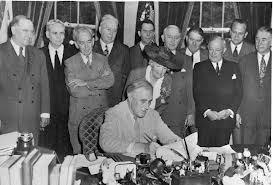While the total enrollment in colleges across the country increased by over 50% from the prewar level of 1.3 million to over 2 million in 1946, with further increases through 1949. [1] Just like in primary and secondary education, democratization was seen to be an important element education at the collegiate level as well. However, it differed at the collegiate level in that the G.I. Bill ““democratized” the collegiate population by making college a viable option for men from a range of sociodemographic backgrounds, including minorities, first-generation Americans, and those from low-income households.”[2] This further attributed to the increase of college students across the nation.
The GI Bill was signed into law by Roosevelt as the Serviceman’s Readjustment Act, Public Law 346, on June 22, 1944.[3] Any persons serving on active duty from September 1940 to July 1947 were eligible for the benefits, although they needed to finish their school before July 1951, with “most men [being] eligible for the maximum benefits, with tours of service often exceeding 3 years.”[4] These benefits ranged from a minimum of 1 year up to 4 years, and depended on the length of service and their age. The “benefits included up to $500 in tuition and educational expenses paid to the institution per academic year and a monthly cash allowance of $65 per month for single veterans and $90 per month for married veterans. At the time, the subsidy for tuition and books was sufficient to cover the charges of traditionally expensive schools like Harvard University.”[5] This funding was given without any preliminary testing or application process.
Despite its successes, the GI Bill and its college programs were not without critics.[6] These often included university faculty who found the lack of standards in tuition rates and difficult process necessary to pay for books and other school supplies. They also feared that with this money given relatively freely, it would lead these students to not appreciate it and led to “education for subsistence.”[7] The university officials argued for the money being given directly to the students so they could spend it as they wished. They also emphasized the need for the veterans to contribute in some manner to their education.
Fellow students and others often thought that this compensation was not appropriately used, and students often abused the privilege. Soldiers returning from the service just wanted to have a good time after what they had been through. Because they were just given the money and supplies, they did not always work as hard as other students. However, they deserved the money and to be compensated for their service. It was also important that they were able to have a college education that they would not have been able to receive without the GI Bill.
[1] John Bound and Sarah Turner, “Going to War and Going to College: Did World War II and the G.I. Bill Increase Educational Attainment for Returning Veterans?” Journal of Labor Economics 20.4 (October 2002): 785.
[2] Ibid.
[3] Ibid.
[4] Ibid.
[5] Ibid.
[6] Amos Yoder, “Lessons of the GI Bill,” The Phi Delta Kappan 44.7 (April, 1963): 342.
[7] Ibid.

